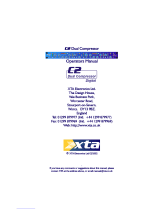
12
676
The Compressor & Limiter Section
These days, deciding whether or not to compress a signal while tracking is a matter of personal preference. It was common
practice in the days of analog tape to keep the lower-level portions of an audio signal well above the noise floor inherent in
magnetic tape. The tape itself could also add a marginal amount of compression. Similarly, in the early days of 16-bit digital
audio, many engineers still preferred to use this method to prevent the loss of resolution in the lower bits while also preventing
the A/D (analog to digital) converters from clipping (which sounds nothing like driving analog tape!).
With the advent of 24-bit digital audio recording (with a theoretical dynamic range of 144 dB), compressing audio during the
tracking stage to fit it on to the recorded medium was no longer necessary. Signals could now be recorded at lower levels
without worry of noise, graininess, or clipping the A/D converters. This is true, however, some engineers still prefer to track
using light to moderate amounts of compression (particularly on more dynamic sources such as drums, bass, acoustic guitar,
clean electric guitar, and vocals) and then apply additional stages of compression during the mixing process. These engineers
will argue that spreading the compression task amongst multiple cascaded compressors during the recording/mixing process
can sound more natural than applying a large amount of compression using a single compressor. This also allows them to
use different ‘flavors’ of compressors during the process and emulate the same workflow used by engineers for decades for
creating the sounds we still love today. Some argue that a high-quality analog compressor simply sounds better than many of
the software compressor plug-ins available. Or that it’s better to get things ‘in-line’ up-front in the analog world, before going
digital. Of course you wouldn’t want to ruin a perfectly good take due to over-compression either. Well, the 676 has a trick
up its sleeve for that too! More about that in a moment. What it really comes down to is how you prefer to work and which
workflow allows you to best create your artistic vision.
The 676 compressor can be effectively used to apply the first round of transparent dynamic control with around 2-5 dB of
compression applied. Recording a signal using the 676 compressor in this way can:
• Provide a more engaging headphone mix for musicians during the recording process, thereby inducing a better musical
performance and adding more life to the track.
• Create a more dynamically-consistent and analog-sounding initial mix, making your recorded tracks more ‘mix-ready’.
• Tighten-up drum tracks.
• Eliminate one stage of compression in your DAW, saving time later in the process and freeing up computer CPU resources
when it comes time to mix.
The 676 compressor is also capable of extremely fast attack and release times, which can be useful for effectively controlling
transients of drums and other percussive instruments. However, care should be taking during the tracking stage to ensure you
don’t over-compress or cause distortion due to overly-fast attack and release times – experience is key here. If you’re worried
about setting the compressor wrong and ruining an otherwise great take, you can simultaneously record a second track with no
compression applied using the PREAMP output. Recording both of these outputs simultaneously can also be used for parallel
compression applications, see ‘Parallel Compression’ on page 18 for more information. A better option may be to
bounce through the 676 compressor during the mixing stage if your A/D and D/A converters are of good quality, see ‘Using
The 676 EQ & Compressor At Mixdown’ on page 22 for more information.
When recording extremely dynamic instruments or vocals (for example, a singer who whispers one moment and screams
the next), another option is to record the uncompressed signal using the PREAMP output and send the compressed signal
from the COMPRESSOR / LIMITER output to the headphone mix. If needed, the limiter can be used in conjunction with the
compressor if the level fluctuations are extreme. This can provide the artist with a more dynamically-consistent headphone mix
where their instrument or voice sits better, allowing them to focus on their performance.
























